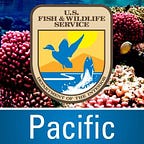Field Notes: A Conversation with Becca Frager at Hakalau Forest
This note is part of our ongoing series bringing you a behind the scenes look at the life and the science of working in remote field camps and National Wildlife Refuges across the Pacific Islands. We sat down with Becca Frager, a biologist with the Pacific Islands Fish and Wildlife Office about her time surveying native forest birds at Hakalau Forest National Wildlife Refuge. This Refuge is home to many of Hawaiʻi’s threatened and endangered honeycreepers and other rare native forest birds.
Where did you go and what was the purpose of the trip?
I spent two days at Hakalau Forest National Wildlife Refuge to assist with forest bird surveys. We conducted organized grid searches and counted all of the birds we saw or heard at each site. These surveys help us gain a better understanding of what birds live in the refuge and the status of the endangered or threatened forest birds of the area, enabling biologists to make informed management decisions for the species.
Have you ever been to Hakalau Forest NWR before?
What was it like?
I had never been there before and I loved it! Hakalau is located several miles from the city and is managed for the protection of native species. It supports a wide diversity of native flora and fauna. As soon as we arrived, I noticed how crisp and cool the air was. We hiked down the mountain slope through various ecosystems. On our search for birds, we hiked through native koa forests, wet ʻōʻhia forests and past numerous native ferns and other plant species, each supporting a different variety of wildlife. We saw or heard every bird we were hoping to record. Hakalau is a beautiful example of Hawaiʻi’s natural ecosystem.
What do you like about Hawaiʻi’s forest birds?
Hawaiʻi’s forest birds are unique and many are not found anywhere else in the world. It feels like a special gift to watch an endangered, bright red-orange ʻākepa snacking on insects or listen to the whimsical calls of numerous ʻiʻiwi’s sipping nectar out of ʻōhiʻa blossoms. Some, like the ʻakiapōlāʻau, found only in upper elevations of the Hawaiian forests, have developed fascinating adaptations. The ʻakiapōlāʻau’s bill has a straight and strong lower mandible, similar to that of a woodpecker, and a long, decurved upper mandible. It’s lower mandible allows it to tap on branches to locate prey and chisel holes in the wood. It can then use itʻs upper mandible to scoop out its meal. Watching and listening to Hawaiʻi’s forest birds in a place like Hakalau is a captivating experience like none other.
Describe a meaningful experience on the trip.
Connecting with Hawaiʻi’s native species motivates me in my work as a wildlife biologist. For me, observing Hakalau’s unique forest birds, breathing in the cool air, and experiencing the native forests reinforced the importance of conserving Hawaiʻi’s native ecosystems. The entire trip was meaningful and I encourage everyone to take time to experience and learn about the natural environments near their homes.
Want to learn more about Hakalau Forest NWR? Click here
The U.S. Fish and Wildlife Service works with others to conserve, protect, and enhance fish, wildlife, plants, and their habitats for the continuing benefit of the American people. For more information, connect with us through any of these social media channels at https://www.facebook.com/PacificIslandsFWS, www.flickr.com/photos/usfwspacific/, or www.twitter.com/USFWSPacific.
